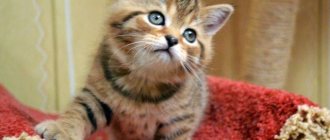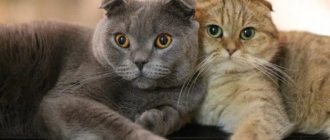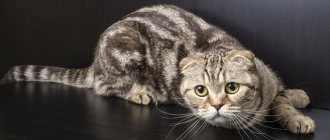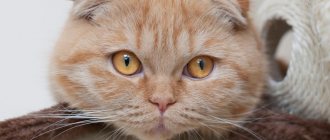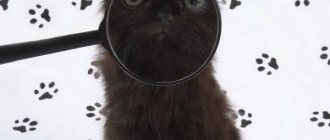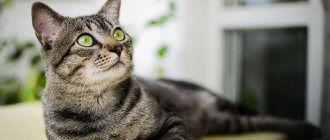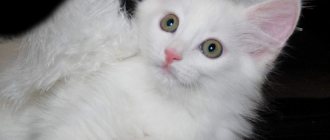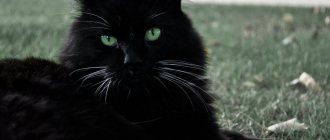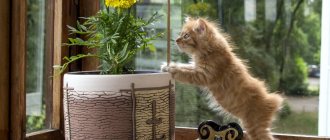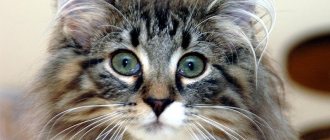The Scottish Fold blue cat is liked for its friendliness, devotion, and sincerity. This breed is young, but has already managed to win the hearts of people. When choosing a breed, you need to know whether it is suitable for you or not. The blue fold cat can be both your best friend and a burden. In order not to make a mistake with your pet, we talked about the characteristics of the Scottish breed and its care.
Scottish fold blue cat
History of the Blue Scots breed
Scottish fold cats appeared about 50 years ago. There are several versions of the origin.
One of them says that the animal appeared as a result of an accidental mating of a wild tabby cat and an unfamiliar cat. This is how the first fold-eared cat in the world appeared - Susie, who became the ancestor of a new breed. Scottish farmers really liked it. Susie began giving birth to kittens frequently. The owners distributed them to their friends. One farmer Mary received a kitten named Snooks as a gift. It was a semi-wild white kitten. The new owner was delighted with him. It was a girl who later also gave birth to a fold-eared kitten. Mary did not understand breeding, so she showed the baby to specialists. Felinologists became interested and developed a new breed.
Snooks and her son were crossed with a male cat and a male cat of the British breed. Their children are considered the first representatives of the Scottish breed.
There are other versions of the appearance of the Scottish Fold. In the seventies of the last century, it was forbidden to breed kittens with drooping ears, since they could not hear normally. There were other pathologies: displacement of the vertebral discs, crooked paws. Specialists had to correct the flaws. During experiments, scientists found that individuals with curved ears should only mate with straight-eared ones. As a result of such experiments, kittens with curved and protruding ears appeared.
Basic colors or solid
The main colors today include:
White
It is believed that this color is dominant over all others, that is, if you breed a white homozygous cat with a cat of any color, all the kittens will be white, however, if the cat was heterozygous for the white gene, then some of the kittens will not inherit the color of the mother. Another option is that when mating a heterozygous white pair, colored kittens can be born.
Black
The coat color is like a raven's wing, the guard hairs are shiny. White hairs on show animals are considered defective, and therefore they are pulled out. A black cat's nose and toe pads should also be black.
Red
What is popularly called red is a rich color without a residual pattern that is most valued. A very rare color, difficult to breed, since often a couple with an excellent red color produces children with the pattern. A red cat should not have a pink nose line, and the fingertips should be pink.
Chocolate
A color introduced into European cat breeds from the eastern group. A chocolate-colored animal should be the color of dark chocolate with a pink nose and toe pads.
Cinnamon or brown
It also came from oriental cats, now it is especially popular. The color is average between red and chocolate, you can call it red-brown. The nose and pads are also pink.
Dimensions and weight
The breed has a medium sized body. Their length is approximately 55cm. Height in a standing position on fours is 30 cm.
The average Scottish Fold blue cat weighs less than an adult cat. The weight of an adult is approximately 3–5 kg, more often 3.5–4.5 kg. The cat's weight reaches 4-5 kg, sometimes 6-7 kg. The cat has a larger head and powerful paws.
Scots have a medium sized body
Anatomical characteristics
The breed has the following characteristics:
• Round head, high forehead, strong massive chin, short wide nose, full cheeks.
• Ears curved forward and down, small to medium in size with pointed tips.
• The eyes are round, expressive, and set wide apart.
• Body of medium size, muscular neck, pronounced shoulders, developed chest.
• Limbs with small round paws and movable toes are proportional to the overall build.
• The tail is wide at the base and gradually tapers towards the tip. It is flexible and medium in size
Scottish Fold kittens
The Scottish breed today is divided into two genetic lines due to breeding work. One line is associated with the British, Persians and even exotics, the other with American Shorthair cats.
The standards of each subspecies will be discussed below, but all Scottish cats have common appearance features that indicate their belonging to the breed.
The head must be round in shape with large round eyes. The breed is characterized by a “childish” expression on its face. The fold-eared varieties are similar in ear shape, and the short-haired subspecies have a very thick undercoat, and resemble teddy bears.
Other breeds may simply be envious of the richness of the colors of the tartans. As a rule, the eye color corresponds to the standard coat color.
The Scottish Fold breed does not exceed average size. The body looks rounded, massive and muscular. The back is straight, the shoulders are strong, the chest is well developed.
The characteristic ball-shaped head has a smooth transition to the neck and a strong, well-defined chin. A short nose seems wide. The small ears, which are slightly set forward and downwards, look interesting. The tips of the ears are rounded.
The Scottish Fold looks at the world with wide, large eyes, reminiscent of an owl, and the color of the eyes will be determined by the color of the coat.
Slender round paws of medium length.
Short fur seems plush due to its density and softness. The pile does not adhere to the body.
A cat's tail can be medium or long, but always tapers to a rounded tip.
The Scottish Straight is a beautiful cat that is small in size and has a sloping body shape. The pussy even seems miniature and compact.
Although the animal is small, its muscles are well developed, including the massive pelvic and shoulder parts. The graceful, rounded paws look strong and feel plush to the touch. The limbs of the subspecies are of medium length.
We suggest you read: Why a cat doesn’t go to the toilet - Tips for keeping cats
The head, like that of other Scottish cats, is located on a short but very strong neck. Scottish Straight males have distinct cheeks and whisker pads.
Representatives of this subspecies have a very neat, wide and short nose. The base of the nose and its oval shape are noteworthy.
Smooth, straight ears with soft and elastic cartilage stand out on the rounded skull.
Scottish Straights are similar in eye shape and look to an owl: they have the same large round eyes. Eye color also depends on coat color.
The soft fur coat without thick undercoat resembles plush. Wool is very dependent on the quality of nutrition and climate.
The length of the tail depends directly on the body parameters of the animal, but has a characteristic narrowing towards a rounded tip.
As already mentioned, the Highland Fold is a Scots cat with long hair.
Her head is perfectly round, she has a strongly pronounced chin, a strong strong neck, a medium body and short limbs with sloping paws. Round eyes set wide apart.
Males have noticeable cheeks and a short and wide nose. Cats' ears seem to be folded down and forward, and seem to be buried in long hair.
The tail of cats is medium and tapering to the tip.
The wool is light, soft and silky.
There was a whole unpleasant story with Scottish Folds in 1971, associated with the reluctance of the largest felinological organization in the UK to include the breed in the official lists. Thanks to the geneticist R. Peltz, the problem was solved. Europe received Scottish Folds from British cats, America - from American Shorthairs. However, in 1976, the CFA finally settled the disputes.
Not everything was smooth with the straight cats either: the cats are very similar in appearance to the British, to whose genes they owe their origin. In 2004, it turned out that the pussies of Scotland differ in character, skeletal mass and skull structure. But today it is prohibited to cross British and Scottish cats.
Scottish cats have a wide choice of colors.
Beautiful colors of chocolate tones:
- plain;
- tortoiseshell;
- tabby;
- smoky;
- bicolor;
- van;
- shaded;
- chinchilla;
- ticked;
- point
The breed is characterized by tipping - the pigment is not distributed evenly along the length of the hair, but only colors the tip of the hair, leaving the rest white. Tipping is found in chinchilla colors, shaded and patterned.
Bicolor colors are popular, consisting of two tones: half white, half blue, cream, red and tabby.
Point colors are popular: the body is light in color, and the muzzle and all protruding parts of the body will be darker. For Scottish cats this is:
- seal point;
- lilac point ;
- blue point;
- chokelit point;
- cream point;
- cake point.
No less beautiful are smoky cats with a uniform coat tone and a white-silver base of the pile.
Solid color Scottish cat:
- blue;
- ebony;
- white;
- lilac;
- faun;
- cream;
- cinnamon.
The rarest colors of tartans today are black, white, chocolate and red.
As mentioned above, breed is not a 100% factor in whether an animal's eyes are a particular color. However, people are accustomed to certain standards and the norm for them is a specific eye color in individuals of certain breeds:
- British breed - bright orange or amber hue.
- Russian Blues have green eyes.
- White British people have blue eyes.
- Black layer - eyes should not be green.
- Scottish cats are green or copper in color.
By paying attention to the fact that kittens' eyes change, you can determine their age.
| Parameter | Grade |
| Head (55) | |
| Ears | 25 |
| Head shape, muzzle, neck, chin, profile | 15 |
| Eyes | 15 |
| Body (40) | |
| Body build, legs and paws | 10 |
| Tail | 20 |
| Wool | 10 |
| Color (5) | |
| Coat color and eye color | 5 |
General Description: The Scottish Fold is the result of a spontaneous mutation from domestic cats in rural Scotland. In England, domestic cats are crossed with British Shorthairs, and in America - British and American Shorthairs.
| Parameter | Description |
| Head | Round shape. The chin is firm, the jaw is strong. The head smoothly turns into a short neck. The whisker pads on the muzzle are well rounded. Males have more prominent cheeks than females. |
| Ears | Bent forward and down. Small, tightly packed ears are preferable to large, loose ears. The ears give roundness to the head. The tips of the ears are rounded. |
| Eyes | Wide open, the expression of the eyes is “sweet”. Large, round, separated by a wide nose. Eye color matches coat color. Blue eye color and mixed eyes are allowed in white, two-colored and van individuals. |
| Nose | Short with a soft curve. A small stop is allowed. The profile is moderate. |
| Body | Medium, round, well filled along the entire length from shoulder to pelvis. The cat must stand firmly on its feet. There should be no hint of fatness or clumsiness of the cat due to short legs. The paws are neat and rounded. There are five toes on the front paws and four on the hind paws. The skeleton is average. Females may be smaller than males. |
| Tail | The Scottish Fold has a medium-length or long tail, but in proportion to the body. Flexible, slightly tapering to a rounded tip. |
| Wool | Shorthair: The coat is dense, plush, and short to medium-short in length. Soft texture. Standing, not tight fitting. Texture may vary depending on coat color and season. Long-haired: medium to long hair. Short hair is acceptable on the face and legs. The feathers, the train on the tail, and the tufts on the paws are clearly distinguishable. |
Disqualification
- Curved, shortened, inflexible, thick tail;
- Crooked fingers;
- Incorrect number of fingers;
- Broken nose.
Medallions and buttons are allowed on individuals of any color and pattern.
White: glossy, pure white. The nose and paw pads are pink. The eyes are blue, the color of copper or gold. In individuals with different eyes, one eye should be blue and the other copper or gold, but the depth of color is the same.
Black: Jet black from root to tip. Without any hint of rust on the tips or smoke on the undercoat. The nose is black, the paw pads are black or brown. Eyes the color of copper or gold.
Blue: A lighter shade of blue is preferred. One tone from nose to tip of tail. A uniform dark color is preferable to a light color with transitions. The nose and paw pads of a Scottish Fold are the same color as their coat color. Eyes the color of copper or gold.
Red: A deep, rich, brilliant red with no shading, blemishes or flecks. The nose and paw pads are brick red. Eyes the color of copper or gold.
Cream: uniform shade of cream throughout the body, without blemishes. Lighter shades are preferred. The nose and paw pads are pink. Eyes the color of copper or gold.
Silver chinchilla: pure white undercoat. The fur on the back, sides, head, and tail is tipped black, which gives a characteristic silvery sparkle. The legs may be slightly shaded towards the bottom. The chin, tips of the ears, belly, and chest are pure white. The rims of the eyes are black, the lips and nose are outlined in black. The nose is brick red. Paw pads are black. The eyes are green or blue-green.
Golden Chinchilla: The undercoat is a rich, warm cream color. The fur on the back, sides, head, and tail is tipped black, which gives a golden shine. The legs may be slightly shaded towards the bottom. The chin, tips of the ears, belly, and chest are creamy. The rims of the eyes, lips, and nose are black. The nose is deep pink. Paw pads are black. The eyes are green or bluish-green.
Silver shaded: the undercoat is white with a mantle of black hairs at the tip on the sides of the body, on the muzzle, tail, with lightening towards the chin, on the chest, belly, under the tail. The Scottish Fold of this color has hair on the legs of the same tone as on the face. The overall appearance is much darker than the chinchilla. The rims of the eyes, lips, and nose are black. The nose is brick red. Paw pads are black. The eyes are green or bluish-green.
Golden Shaded: An undercoat of a rich, warm cream shade with a mantle of hairs tipped with black or dark brown. The fur is shaded on the sides, muzzle, tail, lightened to cream on the chin, chest, belly, and under the tail. The fur on the legs is the same tone as on the face. The rims of the eyes, lips, and nose are black. The nose is brick red. Paw pads are black. The eyes are green or bluish-green.
Color standards and disqualification
There are many color options. With a solid color there are no inclusions. The tone should be rich and even along the entire length of the hairs. If there are inclusions of a different color, then this is already considered a defect, which reduces the rating of a Scottish Fold blue kitten at exhibitions.
The most common solid color is blue. Until recently it was considered a classic. Today this is no longer the case. However, black, white, chocolate and red Scots are rarer animals.
Scotsman with blue color
The main disadvantages of Scottish Fold cats:
- tail stiffness
- ears that do not fit tightly to the skull
- profile with a stop
- stiffness in the spine
- skull deformation
- presence of age spots in the eyes
- undershot or undershot, missing teeth
- wrong number of fingers, crooked fingers
- visible or palpable break in the nose
Animals with dwarfism, umbilical hernia, blindness, strabismus, entropion, or white non-standard spots in the coat color are completely disqualified. Aggressive and alloyed cats are considered defective.
Color chart
The international classification also applies to Scottish cats. The color chart is used to create a description of colors that rarely appear in the population. The table contains an alphanumeric code, in which XXX is the designation of the breed, and lowercase xx is the main color. Numbers from 01 to 35 indicate the color variant.
Many cat lovers are interested in what the rarest and most expensive colors of Scottish cats are. Today there are no problems finding any color, however, among breeders trying to get the maximum variety of colors of kittens from one cat, tortoiseshell cats are very much appreciated, because... they carry the genes of both the red and black series at once.
Matching eye color to coat color
The color of the breed's eyes does not depend on the variety: Scottish Fold, Scottish Straight, Highland Fold, Highland Straight. Sometimes the color is related to coat color.
Most often, Scottish Blue cats have orange or blue eyes. The color of newborn blue fold kittens is different from that of an adult. Babies are mostly blue-blue in color. From a genetic point of view, coloring depends on the amount of pigment and its distribution. The eye color of adult Scots can be blue, green, brown, golden, amber, copper.
There are also odd-eyed individuals, but this is rare. Although nature programmed color during conception, the pigment in the iris develops after birth. Kittens acquire their final color by 4–12 months. For some, the shade is clearly visible already at 4 months, for others only at one year. The most saturated shade is obtained only by two years. This also applies to wool.
Until four months it is difficult to determine what eye color a kitten will have; some people judge this by the color of their coat. For example, blue Scottish cats tend to develop amber eyes as they age. But it is difficult to predict in advance which direction the shade will go.
Scotsman with amber eyes
Colors with white or bicolor
When the main color of a cat is combined with white it is called “bicolor”, but such colors are also distinguished by different amounts of white:
A small amount of white is a medallion; the fingers may be white.
Bicolor
From 30 to 70% of the color is white, usually the paws, belly, chest and a small amount on the sides, there may be white spots on the face. Experts welcome it if the white areas meet at the shoulders with a collar.
Harlequin
The amount of white is from 70 to 95%, only the cap on the head, the tail and several small spots on the body are colored.
Wang
The animal is completely white except for the tail and spots on the head.
All of these variations with white can be painted and/or tortoiseshell.
Character and habits
The Scots are well-mannered, discreet, unobtrusive. Kitties are friendly with people and other pets in the house. They do not enter into conflicts and do not take revenge. If a pet is offended, it will not show aggression, but will hide alone.
Pets are quiet, they will not scream if they need something. They speak about their desires in a gentle voice. If the cat is hungry or wants attention, it will come up to its owner and purr softly, follow him and rub himself.
Individuals are phlegmatic. They love a measured, unhurried lifestyle. They like to lie on the sofa, and they are unlikely to run for a candy wrapper.
The Scots love to take care of themselves. They wash themselves and comb their fur every day. Cats keep everything clean. Their toilet should always be cleaned. A newborn blue Scottish Fold kitten is easy to litter train, but the breed is poorly trained.
The animal gets along well with children. During communication, the pet shows patience. He will not show aggression during play, will not release his claws or scratch. The cat loves his family very much. He will treat every family member well, but only one becomes a favorite.
Scots are devoted to their family
Silver and golden colors
Silver colors are one of the most elegant and popular among cat lovers. Silver is a completely white undercoat on any color.
Painted silver always has an edged nose, and the color of the edges and paw pads matches the color of the coat. The extreme expression of silver is the chinchilla, or shaded color.
Yes, yes, don’t be surprised - an almost white cat, whose guard is 1/8 colored (only the tips of the guard hair), is actually painted.
In combination with the “A” (tabby) gene, silver becomes drawn in any color variation:
- silver marble color;
- silver brindle;
- silver spotted - popularly called "whiskas".
Chinchilla color has two options:
- shaded, when the length of the dyed part of the hair is 1/3;
- shaded or veiled (true chinchilla), with colored tips.
A red chinchilla is called a cameo:
- red cameo (shaded and shaded);
- creamy cameo.
Since the colors fawn and cinnamon also belong to the “O” gene - orange, then theoretically there could be a cameo of cinnamon and fawn, but this is apparently very rare.
If you see a white Scottish cat with green eyes, then it will 100% be a chinchilla.
In combination with the “a” gene (not agouti, solid), silver appears as smoky colors: in this case there is no pattern on the coat, it can be residual on kittens or young animals, but disappears by 8-10 months. The nose of smokes, like solids, has no edging. The smoke looks especially advantageous on long and semi-long fur - as if a darker coat of guard hair was thrown over a white animal.
Nutrition
In order for your pet to be strong and healthy, nutrition must be regular and balanced. The best option is a diet based on natural ingredients. Can be fed with dry food. Experts advise using a varied diet that contains both bagged cat food and natural ingredients.
Scots food
Regular drinking is mandatory. Water must be constantly replenished. Adults should receive food 2-3 times a day. Often there is no need to change types of food, as the stomach may ache. There is no need to eat foods with large amounts of fat, vinegar, salt, or sugar. Food should not be too hot or cold. The diet should include lean meat, fish, milk, and cottage cheese. It is not advisable to give onions, garlic, tomatoes, eggplants.
Peculiarities
Scottish Fold cats are born with folded (Scottish Fold) and normal (Scottish Straight) ears. The gene responsible for folded ears is dominant. One individual with folded ears is enough for the same kittens to be born in the litter. Because of their folded ears, Scottish Folds are sometimes compared to an owl or an elf.
We invite you to read: How to care for a cat? Cat care
Representatives of the breed are distinguished by the fact that they quickly fall asleep on their backs, and prefer to sit with a straight back and widely spread hind legs. They also often take a meerkat pose, stand on their hind legs and direct their curious gaze to the point that is most interesting to them.
Appearance care
Pedigree cats do not have very long fur, so grooming does not require special attention. Scratching them about twice a week is enough. In order to remove dead hair, you must first use a massaging brush, and then a comb with sparse and thick teeth. You need to scratch from head to tail.
It is enough to bathe your pet once a season. You need to check your ears periodically. The sulfur needs to be cleaned out. The claws need to be filed and polished. Eyes need to be checked.
To protect your animal from various problems, it is necessary to get vaccinated at a young age. The first vaccination is carried out at the age of 8 – 12 months. At the age of 5 - 7 months, teeth change; at this time, injections are prohibited.
Content
Speaking of content, it should be mentioned that the Scottish breed is characterized by a number of genetic diseases. Therefore, this cute kitty should be examined regularly by a veterinarian.
Caring for a cat does not bother owners: the coat is combed once a week for short-haired subspecies, and 2 times for long-haired subspecies.
The ears need regular inspection and weekly cleaning with a clean, damp cotton swab.
To keep cats healthy and maintain muscle tone, it is necessary to walk them and play outdoor games with them.
Upbringing
There is a myth about the magical breeding of the Scottish breed. If you do not raise a Scottish cat from childhood, then there can be no talk of any kind of good manners.
In general, we can say that intelligence makes it easy to accustom a cat to a litter box, a scratching post, and decent behavior in public places.
It is unlikely that the plate will fall off the table on purpose - vindictiveness is not in the nature of the Scottish cat. But the question of what the well-mannered pussy was doing on the kitchen table is already addressed to the owner.
All subspecies of Scots are perfectly amenable to educational processes, but this needs to start from childhood.
Bathing
Scottish cats are not bathed often, mainly if the cat is obviously dirty, or before visiting an exhibition.
It is enough to wash the animal’s paws with water if they are very dirty, and once every six months give the cat a full bath. Wash your pet with products intended only for cats.
Many people switch to dry shampoos, which do an excellent job of removing dirt and do not create stress for the animal from contact with water.
Feeding
The owner can choose from several types of food for the furry pet: natural products, dry food or jelly food.
Natural food is always preferable: the owner should worry about the quality and shelf life of the food product. But ready-made food will be better balanced in terms of vitamins and various elements.
In any case, the cat will benefit from beef, chicken breast, boiled liver once a week, low-fat kefir, cottage cheese and boiled yolk. You should not overdo it with fish, it can lead to kidney diseases.
It is useful to include cereals in the menu that fill your pet with energy.
Kitten care
A Scotsman kitten does not require special care.
It can be fed with excellent quality dry food, and it is not necessary to subject it to brushing for no apparent reason. Of course, kittens with long hair will have to be gradually accustomed to brushing, but this should not be done too often. To begin with, it is enough to comb the baby once every 12-15 days.
There is no need to bathe babies unless they get really dirty.
Since childhood, children have their nails cut once a week.
The ears usually do not need cleaning, but if there is an unpleasant odor coming from them, contact a veterinarian.
The eyes are washed with a cotton swab soaked in water with chlorhexidine once a week if they begin to water.
With the health of the Scottish cat, not everything is smooth along the genetic line.
The ear mutation is associated with abnormal development of the skeletal system. Possible bone deformations, hardening of the tail, and difficulty moving. In defense of the breed, we can say that this is often the fault of unscrupulous breeders who cross Fold with Fold.
Hypertrophic cardiomyopathy (heart pathology) is also common in the Scottish cat, but this disease also affects other cat breeds.
The list of diseases includes polycystic kidney disease.
Modern veterinary medicine can help cats in many cases, but it is better to initially take a healthy kitten and take care of its health from childhood.
Short-haired individuals do not require careful grooming. It is enough to comb the coat once a week to maintain its shine and maintain a healthy appearance. It is recommended to comb long-haired individuals 2-3 times a week to prevent the formation of tangles.
It is recommended to clean the ears at least once a month, brush the teeth 1-2 times a week, and trim the nails as they grow.
How to choose the right kitten
If you do not know the basic characteristics of the breed, you may encounter scammers. To be sure of the breed of Scottish Blue kittens, you need to buy from certified nurseries. Not everyone has the opportunity to buy a Scotsman because they are expensive.
How to choose a kitten?
Signs by which you should choose fold-eared blue kittens:
- Short plush fur
- They look like little bear cubs
- Big round eyes
- Ears folded into an envelope
- When viewed from the side, the mouth resembles a smile
- The nose is neat
- Availability of pedigree and documents with vaccinations
Colorful colors
Colored, or color point, or acromelanestic are temperature-dependent colors, which is what causes the coloring of only points - areas of the body with a lower temperature: ears, tail, limbs, muzzle. Color point colors were originally unique to the Siamese cat breed.
However, over time they were transferred to other breeds, and are now prohibited only in aboriginal cat breeds, except for the Siberian, where this color is also called “Neva Masquerade”.
The color is found in any color variations, combined with tabby, silver, gold, smoke and white.
Plain (solid)
This type of color implies a single rich shade of fur without ticking or patterns. Clear spots and hairs of a different shade are not allowed, which is quite difficult to achieve with a cream or red color. Such cats may have, but are undesirable, weak patterns on the tail, muzzle, paws, and less often on the body.
Solid colors are found in intense (black, red, chocolate) and diluted (marble, lilac, cream).
Scottish Fold - black (ebony) color
The color is mostly bright. Red, brown areas of the coat indicate a defect. Representatives of this color, considered mystical in ancient times, are not so rare among folds.
Scottish Fold - chocolate color
This beautiful coloring is not characterized by an undercoat of any other color, light hairs, or various patterns.
White
Snow-white with shine, no yellowness. In newborn babies, spots on the head are allowed to be bluish if there were blue ancestors in the family, or dark spots if one of the ancestors was black. In an adult, the fur becomes perfectly white.
Cinnamon
A rare warm color that looks no less impressive than rich chocolate.
Scottish Fold - color lilac (lavender)
Coffee with milk is how this exquisite, delicate shade of wool is characterized.
INTERESTING TO KNOW: Turkish Angora is a cat of amazing beauty
Fawn
Kittens whose fur is colored in a touching soft beige shade (lightened cinnamon) look touching and cute.
Red
A rare color, implying the presence of an intense solid shade, evenly pigmented and distributed throughout the body. On the forehead and limbs, a faint pattern is acceptable, but undesirable. A light (red) tip of the tail is a breed defect.
Blue color (blue)
A classic color that allows for the entire blue color palette: both light and dark tones. The baby may have moire patterns, which will then disappear.
Cream
Diluted red with the addition of a delicate peach tone. A vague pattern on the forehead and legs is acceptable, but noticeable leopard markings are unacceptable.
Blue wool
Such cats, belonging to group a 25, have fur of a warm beige background with blue ticking. The nose and eyes of these animals are outlined with a grayish rim. The paw pads of blue cats are deep pink. The nose is the color of a withered rose. These cats have yellow eyes.
Tabby (tabby)
Today this is the most popular color. It assumes a certain pattern and zonally colored hairs. It can be presented in two versions - classic and marble.
Characteristics of tabby color:
- light spots on the back of the ears;
- "M" on the frontal zone;
- eyes and nose have eyeliner in the main fur color;
- “necklace” in the chest area;
- closed rings on the limbs and tail.
The clearer the pattern on the coat, the more valuable the cat, the more points the pet will receive at the exhibition.
Tabby colors, depending on the type of pattern, can be of the following types:
- mackerel (tiger) - vertical, contrasting color stripes on the sides, a dark stripe along the spine and tail;
- spotted (spotted) - contrasting round or oval spots on the sides of the body and a vertical torn stripe on the back;
- shaded (marble) - a butterfly pattern on the shoulders, three stripes on the back, spots on the stomach, circles and symmetrical patterns.
- black marble (marble on silver) is the most spectacular, luxurious color.
INTERESTING TO KNOW: Serval cat: how to keep a mini cheetah at home
Tabby colors, depending on color combinations, can be as follows:
- silver - silver, black clear pattern;
- silver-blue - white undercoat, slightly red-tinted mantle on the sides, tail and muzzle.
- red - light red, clearly defined red pattern;
- brown - copper, black pattern;
- blue - creamy blue, blue pattern;
- cream - pale cream, pattern of the same color, but brighter;
- cameo tabby - white, red stripes.
The standard does not allow the presence of gray undercoat, as well as white spots on the limbs, chest, and groin. A white chin is considered undesirable.
Scottish fold and Scottish straight
The official name of the breed of kittens with hanging ears is Scottish Fold, and with straight ears - Scottish Straight (from English straght means “straight”). The Scottish Fold was originally called Lops, after the "loop-eared rabbit" with its ears hanging down to the side of its head. The breed began to be called the Scottish Fold after registration by the felinological organization GCCF (Great Britain).
It is impossible to determine what species a newborn kitten may belong to. The ears begin to droop three weeks after birth. Originally, cats only had a single fold in their ears, but due to selective breeding, breeders have increased this to a double or triple fold, which causes the ear to lie completely against the head.
Both kittens are purebred. But only fold-eared dogs are considered to be show dogs - the Scottish Fold. However, without crossing with Scottish Straight cats there will be no continuation of the breed. They are carriers of the fold-eared gene and irreplaceable successors of the genus of the Scottish Fold with a marbled color. In the photo above there is a litter of kittens with straight and drooping ears from a female Scottish Straight and a male Scottish Fold.
Character of exotic cats
The characteristics of cats belonging to this breed, as well as their character, can be perfectly represented by numerous reviews from the owners of these animals.
In the character of these cats there is absolutely nothing from their distant ancestor - the American Shorthair, but there is a lot from the Persian. Their voice is soft and calm, as they are, and can only be heard in certain situations (for example, when the pet wants something).
Exotic cats have an unusually cute expression on their faces, which is why children simply adore them. Exotic is a calm and patient pet with a peaceful character. These cats are incredibly smart, cheerful, energetic and completely devoid of aggression. It is easy for them to find contact with small children and other pets living in the house.
Exotics are loyal to their owner, so they do not tolerate loneliness and really appreciate increased attention to their person. A pet of an exotic breed is always ready to travel with its owner, since it is really very difficult for him to endure loneliness
Therefore, if you decide to get an exotic cat, remember that you need to respect his affection and reciprocate love with love, under no circumstances leaving him in the care of strangers (for example, if you are moving)
A pet of an exotic breed is always ready to travel with its owner, since it is really very difficult for him to endure loneliness. Therefore, if you decide to get an exotic cat, remember that you need to respect his affection and return love with love, under no circumstances leaving him in the care of strangers (for example, if you move).
